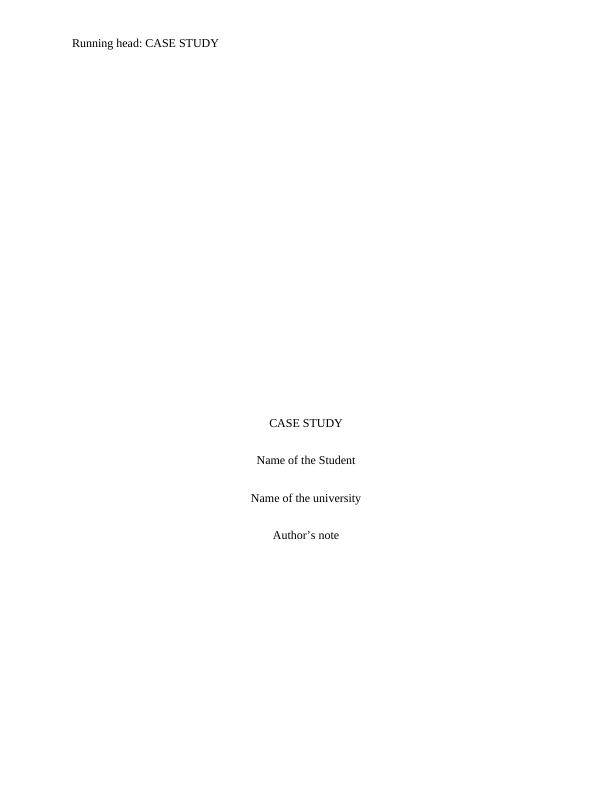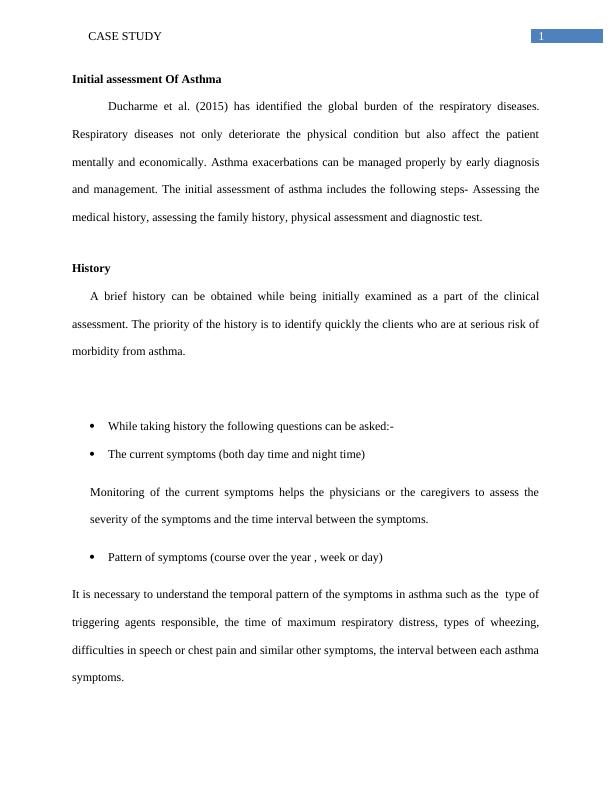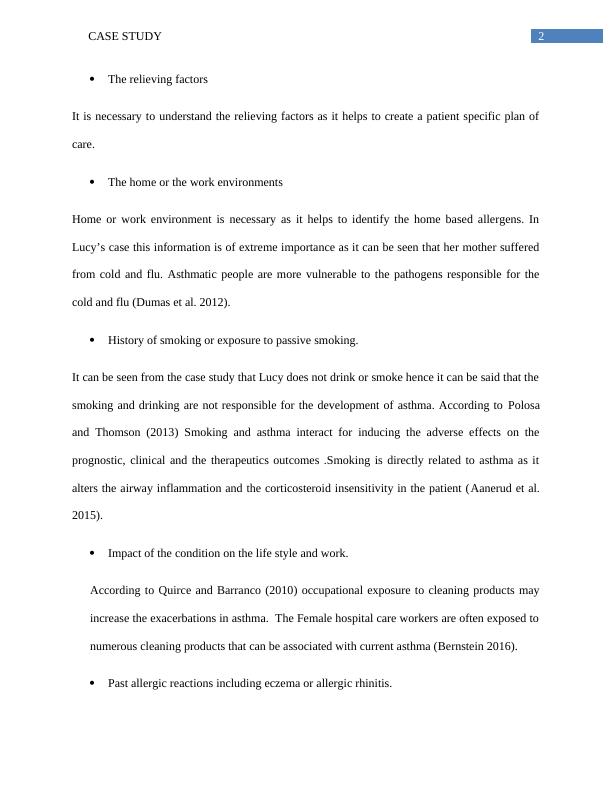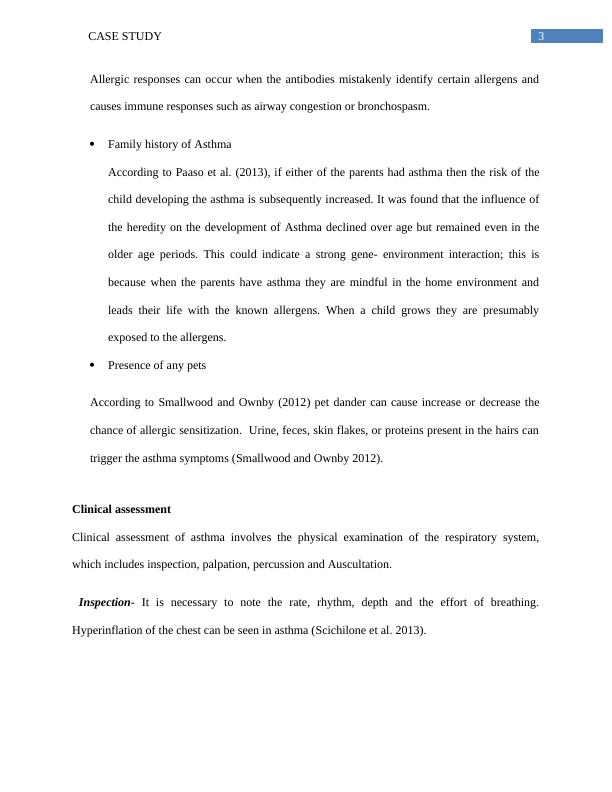Initial Assessment of Asthma: Case Study
Added on 2023-06-12
14 Pages3686 Words262 Views
Running head: CASE STUDY
CASE STUDY
Name of the Student
Name of the university
Author’s note
CASE STUDY
Name of the Student
Name of the university
Author’s note

1CASE STUDY
Initial assessment Of Asthma
Ducharme et al. (2015) has identified the global burden of the respiratory diseases.
Respiratory diseases not only deteriorate the physical condition but also affect the patient
mentally and economically. Asthma exacerbations can be managed properly by early diagnosis
and management. The initial assessment of asthma includes the following steps- Assessing the
medical history, assessing the family history, physical assessment and diagnostic test.
History
A brief history can be obtained while being initially examined as a part of the clinical
assessment. The priority of the history is to identify quickly the clients who are at serious risk of
morbidity from asthma.
While taking history the following questions can be asked:-
The current symptoms (both day time and night time)
Monitoring of the current symptoms helps the physicians or the caregivers to assess the
severity of the symptoms and the time interval between the symptoms.
Pattern of symptoms (course over the year , week or day)
It is necessary to understand the temporal pattern of the symptoms in asthma such as the type of
triggering agents responsible, the time of maximum respiratory distress, types of wheezing,
difficulties in speech or chest pain and similar other symptoms, the interval between each asthma
symptoms.
Initial assessment Of Asthma
Ducharme et al. (2015) has identified the global burden of the respiratory diseases.
Respiratory diseases not only deteriorate the physical condition but also affect the patient
mentally and economically. Asthma exacerbations can be managed properly by early diagnosis
and management. The initial assessment of asthma includes the following steps- Assessing the
medical history, assessing the family history, physical assessment and diagnostic test.
History
A brief history can be obtained while being initially examined as a part of the clinical
assessment. The priority of the history is to identify quickly the clients who are at serious risk of
morbidity from asthma.
While taking history the following questions can be asked:-
The current symptoms (both day time and night time)
Monitoring of the current symptoms helps the physicians or the caregivers to assess the
severity of the symptoms and the time interval between the symptoms.
Pattern of symptoms (course over the year , week or day)
It is necessary to understand the temporal pattern of the symptoms in asthma such as the type of
triggering agents responsible, the time of maximum respiratory distress, types of wheezing,
difficulties in speech or chest pain and similar other symptoms, the interval between each asthma
symptoms.

2CASE STUDY
The relieving factors
It is necessary to understand the relieving factors as it helps to create a patient specific plan of
care.
The home or the work environments
Home or work environment is necessary as it helps to identify the home based allergens. In
Lucy’s case this information is of extreme importance as it can be seen that her mother suffered
from cold and flu. Asthmatic people are more vulnerable to the pathogens responsible for the
cold and flu (Dumas et al. 2012).
History of smoking or exposure to passive smoking.
It can be seen from the case study that Lucy does not drink or smoke hence it can be said that the
smoking and drinking are not responsible for the development of asthma. According to Polosa
and Thomson (2013) Smoking and asthma interact for inducing the adverse effects on the
prognostic, clinical and the therapeutics outcomes .Smoking is directly related to asthma as it
alters the airway inflammation and the corticosteroid insensitivity in the patient (Aanerud et al.
2015).
Impact of the condition on the life style and work.
According to Quirce and Barranco (2010) occupational exposure to cleaning products may
increase the exacerbations in asthma. The Female hospital care workers are often exposed to
numerous cleaning products that can be associated with current asthma (Bernstein 2016).
Past allergic reactions including eczema or allergic rhinitis.
The relieving factors
It is necessary to understand the relieving factors as it helps to create a patient specific plan of
care.
The home or the work environments
Home or work environment is necessary as it helps to identify the home based allergens. In
Lucy’s case this information is of extreme importance as it can be seen that her mother suffered
from cold and flu. Asthmatic people are more vulnerable to the pathogens responsible for the
cold and flu (Dumas et al. 2012).
History of smoking or exposure to passive smoking.
It can be seen from the case study that Lucy does not drink or smoke hence it can be said that the
smoking and drinking are not responsible for the development of asthma. According to Polosa
and Thomson (2013) Smoking and asthma interact for inducing the adverse effects on the
prognostic, clinical and the therapeutics outcomes .Smoking is directly related to asthma as it
alters the airway inflammation and the corticosteroid insensitivity in the patient (Aanerud et al.
2015).
Impact of the condition on the life style and work.
According to Quirce and Barranco (2010) occupational exposure to cleaning products may
increase the exacerbations in asthma. The Female hospital care workers are often exposed to
numerous cleaning products that can be associated with current asthma (Bernstein 2016).
Past allergic reactions including eczema or allergic rhinitis.

3CASE STUDY
Allergic responses can occur when the antibodies mistakenly identify certain allergens and
causes immune responses such as airway congestion or bronchospasm.
Family history of Asthma
According to Paaso et al. (2013), if either of the parents had asthma then the risk of the
child developing the asthma is subsequently increased. It was found that the influence of
the heredity on the development of Asthma declined over age but remained even in the
older age periods. This could indicate a strong gene- environment interaction; this is
because when the parents have asthma they are mindful in the home environment and
leads their life with the known allergens. When a child grows they are presumably
exposed to the allergens.
Presence of any pets
According to Smallwood and Ownby (2012) pet dander can cause increase or decrease the
chance of allergic sensitization. Urine, feces, skin flakes, or proteins present in the hairs can
trigger the asthma symptoms (Smallwood and Ownby 2012).
Clinical assessment
Clinical assessment of asthma involves the physical examination of the respiratory system,
which includes inspection, palpation, percussion and Auscultation.
Inspection- It is necessary to note the rate, rhythm, depth and the effort of breathing.
Hyperinflation of the chest can be seen in asthma (Scichilone et al. 2013).
Allergic responses can occur when the antibodies mistakenly identify certain allergens and
causes immune responses such as airway congestion or bronchospasm.
Family history of Asthma
According to Paaso et al. (2013), if either of the parents had asthma then the risk of the
child developing the asthma is subsequently increased. It was found that the influence of
the heredity on the development of Asthma declined over age but remained even in the
older age periods. This could indicate a strong gene- environment interaction; this is
because when the parents have asthma they are mindful in the home environment and
leads their life with the known allergens. When a child grows they are presumably
exposed to the allergens.
Presence of any pets
According to Smallwood and Ownby (2012) pet dander can cause increase or decrease the
chance of allergic sensitization. Urine, feces, skin flakes, or proteins present in the hairs can
trigger the asthma symptoms (Smallwood and Ownby 2012).
Clinical assessment
Clinical assessment of asthma involves the physical examination of the respiratory system,
which includes inspection, palpation, percussion and Auscultation.
Inspection- It is necessary to note the rate, rhythm, depth and the effort of breathing.
Hyperinflation of the chest can be seen in asthma (Scichilone et al. 2013).

End of preview
Want to access all the pages? Upload your documents or become a member.
Related Documents
RESPIRATORY SYSTEM CASE STUDY 2022lg...
|10
|2709
|12
Incorporating Asthma Patient Interview: Understanding Symptoms and Triggers | Clinical Practice Integrationlg...
|8
|1512
|279
PCAL Workshop for 401210: Health Variations 3lg...
|11
|2819
|439
Health Variation Question Answer 2022lg...
|8
|1873
|22
Pathophysiology Acute Severe Asthmalg...
|9
|1992
|494
Asthma Management - Assignmentlg...
|7
|1545
|45
